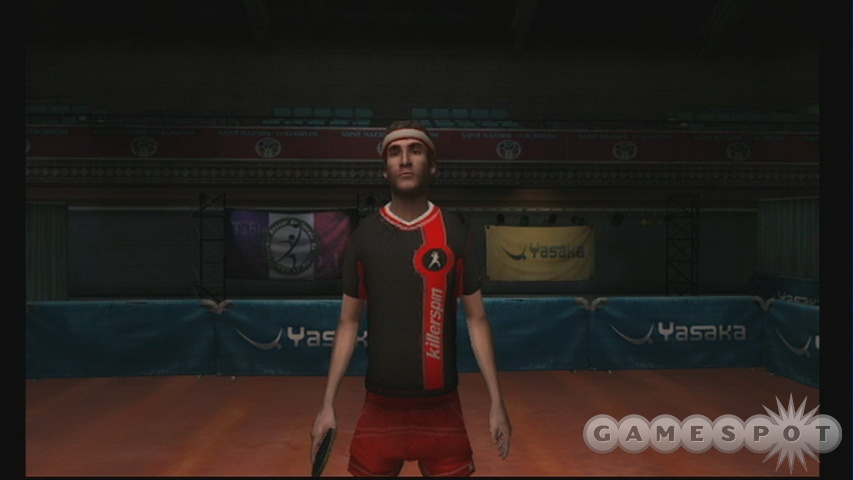When Rockstar Games presents Table Tennis originally hit the Xbox 360 nearly a year and a half ago, it offered a stripped-down and serious-minded ping-pong experience that backed up its breakneck gameplay with a sweaty, realistic presentation. What it lacked in features, it made up for with focus and intensity. On paper, Table Tennis on the Wii is a no-brainer. Tennis was arguably one of the best experiences that Wii Sports had to offer; thus, the idea of marrying that kind of tactile action with the gritty atmosphere and deep gameplay of what Rockstar did sounded potentially even better than the original Table Tennis. In practice, the game comes close to accomplishing all of these, but this isn't horseshoes or hand grenades, and coming close just leaves you pining over misspent potential.

The new Wii-specific controls in Table Tennis attempt to split the difference between the gameplay styles of Virtua Tennis and Wii Sports tennis in a few different ways. Your standard control scheme uses only the Wii Remote and has you swinging it around as if it were an actual paddle. There's a good amount of nuance to it because you can aim your shot by swinging the remote up, down, left, right, or some combination thereof, and holding a direction on the D pad as you swing adds spin to the ball. In this control scheme, the game handles all player movement and generally does a good job, allowing you to focus entirely on your swing. The other two control schemes are basically just permutations of this setup, though both make use of the Nunchuk to give you greater control over specific aspects of the action. The control freak option uses the analog stick on the Nunchuk for player movement, while the sharp shooter allows for more detailed control over ball placement.
All three options work pretty well, though in our experience, the control freak setup isn't as useful as the other two because the game handles player movement well enough. Considering the depth originally afforded on the Xbox 360, it's impressive how much made it here. Still, there are compromises that sap the game of some of its kinetic feel. It's much more difficult to miss the table with the standard control scheme, which makes the game much, much easier. The biggest problem, though, is the incredible disconnect between your movement and the action onscreen. Rather than operating on a one-to-one control scale, where what you see correlates directly to your movement in real time, you can swing at any time that the ball is headed toward you, and your player will automatically swing when the time is right. The game actually encourages you to swing as early as possible because the strength of your spin is determined by how long you hold the D pad. It's entirely functional, but it doesn't make you feel like you're really playing table tennis any more than the 360 version did, which would seem like the whole point of bringing Table Tennis to the Wii in the first place.
Although the gameplay was surprisingly tense and exciting on the Xbox 360, the game's look--which featured incredibly detailed, lifelike players that are still pretty impressive--was arguably the big draw. Considering the chasm between the technical capacities of the Xbox 360 and the Wii, it shouldn't be surprising that the visuals have been scaled back a bit. The game runs well enough, but in the process of removing all the little technical tricks that gave the game such a distinctly grimy feel, the game has lost much of its personality. The best-looking Wii games are those that rely on the strength of their art style, rather than their technical prowess, to carry the visuals. In the case of Table Tennis, the art style was originally so dependent on highly detailed textures and subtle lighting effects that without them, it just looks kind of bland. The game still sounds great, for what it's worth, with authentic-sounding crowds and table noises. One minor ding against the sound concerns the paddle noise that comes out of the speaker on the Wii Remote, which you'll hear whenever you swing it. It's a good way to let you know that your swing has registered, but it also exacerbates the disconnect between your movement and the game, especially in a two-player match.

Outside of the different control schemes, Rockstar hasn't tinkered with the contents of Table Tennis one iota. You've got the same gallery of 11 fictional, international ping-pong pros, each with his or her own play style and attributes, as well as 19 different venues that range from rec center to national stadium. The modes of play are still incredibly lean. There are three different tournaments, as well as an exhibition mode where you can play against either the computer or another live player, though unfortunately, online play has been omitted. It was much easier to excuse such a limited number of options when the gameplay and the presentation were so razor-sharp on the 360, but here's it's compounded by the other shortcomings of the Wii version.
Rockstar Games presents Table Tennis on the Wii feels like some kind of parable for developers porting existing games to the Wii. Even if your game seems tailor-made for the platform and the genre in question has seen previous success there, as was the case with Table Tennis, it's never a sure thing.